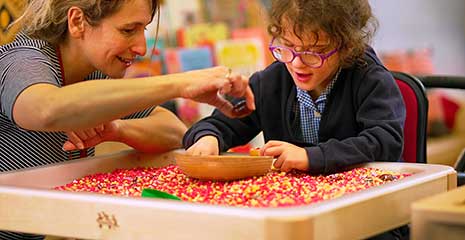Exploring food through the senses
A fun and engaging approach for early years
| March 2025We’ve all heard the phrase “we eat with our eyes”. However, this phrase is only partly true. We eat with all our senses. When you walk past a bakery and smell the bread being baked, when you hear the sound of corn popping, you are using senses that stimulate your brain and engage you with food. I’m Sean Cowden, Health & Food Programme Manager at London Early Years Foundation and I’m going to share some ways to use food sensory activities in your setting.
Children use their senses from a very early age to help them understand the world. It’s important to allow children the opportunity to explore sensory play with food to help engage them with certain foods, even if they don’t want to try it “just now.”
There is a large stigma around using food in play, especially considering the cost-of-living crisis and families living with food insecurity. Food can be used in play without waste and can be beneficial for reducing waste in the future, as some children will become more engaged with food and more likely to try more and eat more.
Ways to integrate sensory food play at your setting
Touch: Allowing the children to touch different fruit and vegetables (without the anxiety that they may be coerced to eat something they don’t want to) can support engagement with food. When you bring in the food shop, let the children see and feel the unprepped foods first, then simply wash and cook!
See: A home-corner in the setting can provide a wide range of wonderful learning experiences, one of which is food engagement. Bring out some of the fruits and vegetables that you will use for snack time and let the children see them in their natural form. I once heard a child tell a teacher that the pineapple she was holding “wasn’t a pineapple” and that “a pineapple is yellow and comes in a plastic box”. The girl’s eyes lit up when the teacher then sliced through it. There are many great opportunities to incorporate visual stimulation into food play. Using different colours of peppers and apples, exploring various stages of banana ripeness, and slicing exotic fruits like dragon fruit can reveal surprising changes in colour and appearance.
Smell: Certain smells can unlock memories or provoke imagination and thought. When I smell rosemary, for example, it always makes me think about roast lunches with my family. If you grow herbs in your setting (which I highly recommend as it has a plethora of learning benefits), why not let the children rub their fingers on it and ask them how it makes them feel.
Another great activity that includes smell can be grabbing some spices from the kitchen and letting the children sniff and describe the smells. Cinnamon, allspice, and nutmeg are great to use. Maybe stay away from the chilli powder!
Hear: We don’t often think about listening to food when thinking about engagement with food, but anything fun and memorable will, ultimately, support engagement with food. We could listen to an orange. Does it make a sound? No, not really. But wasn’t it funny listening to a piece of fruit?
Other examples can include holding sticks of celery up to our ears and listening to the sound as we snap it in half. Or the children could try covering their ears as they chew on fruits like apples, blueberries and bananas. This will enhance the sound from the child’s mouth to their ears, and can be a really fun activity.
Taste: Of course it is important for children to taste food, and most of the activities above can end with tasting. Children shouldn’t be forced to taste any of the food during food sensory provocations as this can have the opposite effect of what we are trying to achieve. There is a wonderful organisation called TastED who work with Early Years settings to provide food-based sensory activities and guidance. They have the motto “You don’t have to try it and you don’t have to like it”. I’m a massive advocate of this approach as it allows the children to feel safe, and increases the likelihood of food engagement over time.
Next time you are eating your favourite meal, think about all the reasons it’s your favourite. Does it taste incredible? Does the smell remind you of a fond memory? Is it the texture of the food you love? Does the sight of it make your mouth water? Does the sound of the food being cut or snapped heighten your enjoyment? For some, it could be all five.
Conclusion
Food sensory experiences help children build confidence, curiosity, and positive relationships with food. Engaging all five senses – touch, sight, smell, sound, and taste – encourages children to explore new foods in a pressure-free and enjoyable way. By incorporating simple sensory activities into daily routines, early years settings can create meaningful experiences that support learning and well-being. After all, food is more than just something we eat – it’s an opportunity for discovery, connection, and joy.











